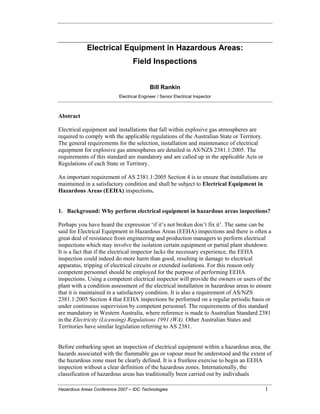Roar Solutions for Dummies
Roar Solutions for Dummies
Blog Article
The 9-Second Trick For Roar Solutions
Table of ContentsThe Single Strategy To Use For Roar SolutionsRoar Solutions - Questions6 Simple Techniques For Roar Solutions
In such an environment a fire or explosion is possible when 3 fundamental conditions are satisfied. This is usually referred to as the "hazardous location" or "burning" triangular. In order to protect setups from a possible surge an approach of evaluating and categorizing a possibly harmful location is required. The function of this is to make sure the proper option and installment of equipment to inevitably stop a surge and to ensure security of life.
(http://prsync.com/roar-solutions/)
No devices must be installed where the surface area temperature level of the tools is above the ignition temperature of the provided hazard. Below are some typical dirt hazardous and their minimum ignition temperature. Coal Dust 380C 225C Polythene 420C (melts) Methyl Cellulose 420C 320C Starch 460C 435C Flour 490C 340C Sugar 490C 460C Grain Dust 510C 300C Phenolic Resin 530C > 450C Aluminium 590C > 450C PVC 700C > 450C Soot 810C 570C The possibility of the threat being existing in a focus high enough to trigger an ignition will differ from area to area.
In order to categorize this danger an installment is split right into areas of danger depending upon the amount of time the harmful exists. These areas are described as Zones. For gases and vapours and dusts and fibers there are three zones. Area 0 Area 20 An unsafe environment is highly most likely to be present and might exist for extended periods of time (> 1000 hours each year) or perhaps continuously Area 1 Zone 21 A hazardous ambience is feasible however not likely to be existing for extended periods of time (> 10 450 C [842 F] A classification of T6 implies the minimum ignition temperature level is > 85 C [185 F] Unsafe area electric devices possibly developed for use in greater ambient temperature levels. This would certainly indicated on the score plate e.g. EExe II C T3 Ta + 60C( This suggests at 60C ambient T3 will certainly not be exceeded) T1 T1, T2, T3, T4, T5, T6 T2 T2, T3, T4, T5, T6 T3 T3, T4, T5, T6 T4 T4, T5, T6 T5 T5, T6 T6 T6 A T Course score of T1 indicates the maximum surface area temperature level created by the tool at 40 C is 450 C. Thinking the associated T Class and Temperature ranking for the devices are ideal for the location, you can always use a tool with an extra strict Division rating than needed for the location. There isn't a clear solution to this question unfortunately. It truly does depend upon the kind of equipment and what repair work need to be executed. Tools with particular test procedures that can't be executed in the area in order to achieve/maintain 3rd party ranking. Should return to the factory if it is prior to the equipment's service. Field Repair Work By Authorised Personnel: Complex screening might not be called for however certain treatments might require to be complied with in order for the tools to maintain its 3rd party score. Authorised personnel have to be utilized to execute the job appropriately Repair must be a like for like replacement. New component should be thought about as a straight substitute calling for no unique screening of the equipment after the repair service is full. Each tool with a hazardous rating must be examined independently. These are outlined at a high level below, but also for even more thorough details, please refer straight to the guidelines.
9 Simple Techniques For Roar Solutions
The devices register is a comprehensive database of devices records that consists of a minimum set of areas to determine each thing's place, technological specifications, Ex category, age, and environmental data. The proportion of Detailed to Shut examinations will be identified by the Equipment Risk, which is evaluated based on ignition risk (the chance of a source of ignition versus the possibility of a flammable environment )and the dangerous location classification
( Zone 0, 1, or 2). Applying a robust Risk-Based Examination( RBI )method is important for making sure conformity and security in managing Electric Devices in Hazardous Locations( EEHA).
The Single Strategy To Use For Roar Solutions

In terms of explosive risk, a dangerous area is an environment in which an explosive environment is present (or may be anticipated to be existing) in amounts that call for unique preventative measures for the construction, setup and use equipment. high voltage courses. In this write-up we check out the challenges faced in the work environment, the risk control actions, and the needed proficiencies to work safely
These materials can, in certain problems, create explosive environments and these can have major and terrible repercussions. Most of us are acquainted with the fire triangle remove any one of the three elements and the fire can not occur, but what does this mean in the context of dangerous areas?
In many circumstances, we can do little concerning the degrees of oxygen airborne, but we can have significant impact on sources of ignition, for instance electric equipment. Harmful locations are recorded on the hazardous location classification illustration and are determined on-site by the triangular "EX" sign. Below, amongst other essential information, areas are split right into 3 kinds depending on the danger, the probability and duration that an explosive ambience will exist; Area 0 or 20 is deemed the most hazardous and Area 2 or 22 is deemed the least.
Report this page